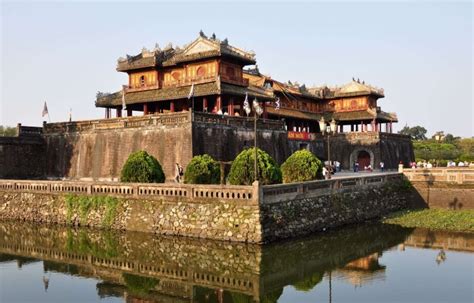When it comes to exploring the rich culture and history of Vietnam, no trip is complete without a visit to the charming city of Hue. As the former imperial capital of the country, Hue is steeped in history and tradition, offering visitors a glimpse into Vietnam’s royal past and the enduring beauty of its heritage. In this blog post, we will delve into the timeless charm of Hue and uncover the hidden gems that make this city a must-visit destination. From the opulent imperial citadel to the tranquil Perfume River, and from the mouthwatering cuisine to the exquisite traditional crafts, there is so much to discover and appreciate in Hue. Join us as we embark on a journey through the history, culture, and artistry of this enchanting city, and uncover the allure that has captivated travelers for centuries.
History and Heritage of Hue
Hue, the former capital of Vietnam, is a city with a rich history and vibrant heritage. The city was once the political, cultural and religious center of the Nguyen Dynasty, which ruled from 1802 to 1945. The Imperial City, a UNESCO World Heritage site, is a testament to the grandeur and influence of this dynasty in Vietnamese history.
Visitors to Hue can explore the ancient tombs, pagodas, and temples that are scattered throughout the city, each with its own unique story and significance. The imposing citadel, with its intricate architecture and well-preserved structures, offers a glimpse into the royal history of Vietnam.
The history of Hue is also intertwined with the country’s struggle for independence and reunification. The city was heavily impacted during the Vietnam War, and remnants of the conflict can still be seen in the form of war-damaged buildings and historical sites.
Today, Hue’s history and heritage continue to attract tourists from around the world, eager to immerse themselves in the rich cultural tapestry of this captivating city.
Exploring Hue’s Imperial City
Hue’s Imperial City is a majestic and historical site filled with rich history and heritage. The city was the former capital of Vietnam and served as the political, cultural, and religious center of the Nguyen Dynasty. Walking through the ancient citadel, visitors can admire the impressive architecture and learn about the fascinating stories behind the imperial era.
Exploring the Imperial City means experiencing the grandeur of the past, as the site is home to numerous palaces, temples, pavilions, and gardens. The intricate designs and lavish decorations showcase the traditional crafts and artistry of the Vietnamese people, allowing visitors to witness the skilled workmanship of the past.
One of the highlights of exploring Hue’s Imperial City is the chance to take part in a guided tour. Professional guides provide insight into the historical significance of each building and share captivating stories about the rulers and their delicious cuisine and lavish lifestyles.
Cruising the beautiful Perfume River that winds through the city offers a unique perspective of Hue’s Imperial City. Visitors can witness the stunning views of the historical site from the water, providing a different and unforgettable experience of this imperial wonder.
Cruising the Perfume River
One of the most enchanting experiences you can have in Hue is a cruise along the Perfume River. As you glide along the gentle waters, you’ll be surrounded by breathtaking scenery and traditional wooden boats. The name Perfume River is derived from the fact that in autumn, flowers from orchards upriver fall into the water, giving off a sweet fragrance along the riverbanks.
During your cruise, you’ll have the opportunity to visit several historical landmarks such as the Thien Mu Pagoda and the Imperial Tomb of Minh Mang. These sites offer a glimpse into the rich history and culture of Hue, and provide a unique perspective from the water.
For a truly immersive experience, consider taking a dinner cruise along the Perfume River. You’ll be treated to a delicious meal of traditional Hue cuisine while taking in the mesmerizing views of the city lit up at night. It’s a romantic and memorable way to experience the beauty of Hue.
Whether you choose a daytime or evening cruise, exploring the Perfume River is a must-do activity during your visit to Hue. The tranquility and beauty of the river will leave a lasting impression and create memories to cherish.
Delicious Cuisine of Hue
Hue, the former capital of Vietnam, is not only famous for its stunning architecture and rich history, but also its delicious cuisine. The city’s cuisine is a combination of royal elegance and peasant simplicity, creating a truly unique and flavorful experience for anyone who tries it.
One of the most popular dishes in Hue is Bun Bo Hue, a spicy noodle soup made with beef and pork. The broth is flavored with lemongrass and shrimp paste, giving it a distinct and aromatic taste that is beloved by locals and visitors alike. Another must-try dish is Banh Khoai, a crispy pancake filled with shrimp, pork, and bean sprouts, served with a side of fresh herbs and dipping sauce.
In addition to savory dishes, Hue is also famous for its unique desserts. One of the most popular sweets in the city is Chè, a sweet soup made with a variety of ingredients such as mung beans, coconut milk, and fruit. It’s a refreshing and satisfying way to end a meal in Hue.
Visiting Hue is not just about seeing historical sites and beautiful landscapes; it’s also about immersing yourself in the wonderfully diverse and flavorful cuisine that the city has to offer. From spicy soups to delicate desserts, the food of Hue is a testament to the city’s rich cultural heritage and should not be missed by any food lover.
Traditional Crafts and Artistry in Hue
Hue, the ancient capital of Vietnam, is not only known for its rich history, but also for its traditional crafts and artistry. The city has a long-standing tradition of producing beautiful handicrafts, intricate artwork, and exquisite textiles.
One of the most renowned crafts in Hue is the art of making ao dai, the traditional Vietnamese dress. Skilled artisans carefully hand-stitch these garments, often embellishing them with delicate embroidery and stunning beadwork. The ao dai reflects the country’s culture and aesthetic beauty, and the craftsmanship involved is truly impressive.
Another traditional craft that thrives in Hue is the production of wooden sculptures. Artisans carve intricate designs and patterns into wood, creating stunning pieces of art that are often used to adorn temples and pagodas throughout the city. The level of detail and precision in these sculptures is a testament to the talent and dedication of the craftsmen.
Hue is also known for its vibrant and colorful folk paintings. These traditional artworks often depict scenes from Vietnamese folklore, history, and daily life. The artists use natural pigments and indigenous materials to create these exquisite paintings, which are highly sought after by art collectors and enthusiasts.
Frequently Asked Questions
What is the history and heritage of Hue, Vietnam?
Hue, Vietnam, is known for its rich history as the former imperial capital of the country. It is home to ancient citadels, royal tombs, and pagodas that reflect the city’s royal past.
What can you explore in Hue’s Imperial City?
Hue’s Imperial City is a UNESCO World Heritage site that offers a glimpse into the country’s royal history. Visitors can explore the Forbidden Purple City, royal palaces, temples, and ceremonial halls within its walls.
What are the highlights of cruising the Perfume River in Hue?
Cruising the Perfume River in Hue allows visitors to enjoy picturesque views of the city and its surroundings. The river is lined with pagodas, shrines, and gardens, offering a peaceful and scenic experience.
What are some delicious cuisines to try in Hue?
Hue is famous for its unique and flavorful cuisine, including dishes such as bun bo Hue (spicy beef noodle soup), banh khoai (savory pancakes), and various local delicacies that showcase the city’s culinary heritage.
What traditional crafts and artistry can be found in Hue?
Hue is known for its traditional crafts and artistry, including the intricate art of making conical hats, delicate silk weaving, and the production of traditional musical instruments such as the royal court’s instruments.
How does the timeless charm of Hue attract visitors?
The timeless charm of Hue lies in its cultural and historical significance, with a blend of natural beauty, ancient architecture, and traditional arts and crafts that continue to captivate visitors from around the world.
What makes Hue, Vietnam, a must-visit destination for travelers?
Hue’s rich history, stunning landscapes, delicious cuisine, and vibrant arts and culture make it a must-visit destination for travelers seeking to immerse themselves in the timeless charm of Vietnam.






